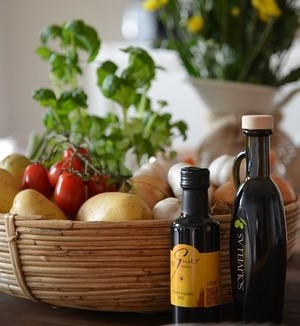Pomegranate salad is a flavorful, colorful dish that incorporates fresh ingredients to deliver a perfect balance of taste, texture, and nutrition. It’s a favorite for holiday meals, festive gatherings, and even light, refreshing lunches. What sets this salad apart is the unique combination of tangy, juicy pomegranate seeds and complementary ingredients like greens, nuts, cheeses, and vibrant dressings.
This salad is popular across different cultures and seasons, from North American fall and winter tables to Mediterranean summer spreads. It’s highly versatile and can be customized with various fruits, vegetables, and dressings to fit different tastes and preferences.
Why Pomegranate Salad is Perfect for Any Season
Pomegranate salad’s versatility makes it an ideal dish to prepare all year round. Here’s why it works so well in different seasons:
- Fall and Winter: Pomegranates are in season during these colder months, making this salad a refreshing addition to heavier holiday meals. Its bright red seeds bring a festive touch to Thanksgiving or Christmas tables.
- Spring and Summer: During the warmer months, pomegranate salad becomes a light, hydrating meal option. The fresh greens, crisp fruits, and juicy seeds create a cooling and energizing dish perfect for outdoor picnics or light lunches.
Ingredients Overview

The beauty of pomegranate salad lies in its ingredients, each of which plays a critical role in making the dish stand out. These elements combine for a delightful mix of flavors and textures, from the crunch of nuts to the creaminess of cheese and the juiciness of fresh fruits.
Pomegranate: The Star Ingredient
Pomegranates are the centerpiece of this salad, offering a unique flavor profile and several health benefits.
- Flavor Profile: Pomegranate seeds (arils) are juicy, sweet-tart bursts of flavor that balance the savory and creamy ingredients in the salad.
- Health Benefits: Pomegranates are high in antioxidants, which help fight inflammation and protect the body from chronic diseases. They are also rich in vitamins C and K and contain fiber, promoting digestion.
- Visual Appeal: The bright red seeds add an attractive pop of color, making the salad not only delicious but also visually stunning.
Additional Ingredients for Texture and Flavor
Each additional ingredient in the salad serves to enhance the flavors and textures, creating a more complex dish. Here are some common ingredients and their role in the salad:
- Greens:
- Baby spinach
- Arugula
- Kale
- Mixed salad greens
These provide a fresh, crisp base and are rich in vitamins A, C, and K.
- Fruits:
- Apples or pears (sliced thinly for sweetness and crunch)
- Oranges or mandarins (for a citrus burst)
Fruits balance the tartness of pomegranate seeds and add a natural sweetness.
- Nuts:
- Pecans
- Walnuts
- Almonds
Nuts add crunch and healthy fats, which improve the salad’s overall texture and richness.
- Cheese:
- Feta (for creaminess and tanginess)
- Goat cheese (adds a soft, mild flavor)
- Blue cheese (offers a stronger, more pungent flavor)
Cheese provides creaminess, which contrasts the crunch of nuts and pomegranate seeds.
Dressings to Complement the Salad
The dressing is the final touch that pulls the salad’s flavors together. Popular options include:
- Pomegranate Vinaigrette:
- Pomegranate juice
- Olive oil
- Red wine vinegar
This dressing mirrors the sweet-tart notes of pomegranate and adds depth to the salad.
- Lemon-Honey Dressing:
- Fresh lemon juice
- Honey
- Olive oil
This dressing offers a light, sweet and tangy flavor that enhances both the fruit and greens.
- Balsamic Vinaigrette:
- Balsamic vinegar
- Olive oil
- Dijon mustard
For a richer, more robust flavor, balsamic vinaigrette pairs beautifully with the salad’s earthy and sweet notes.

Nutritional Benefits of Pomegranate Salad
In addition to its delicious flavor, pomegranate salad offers a variety of health benefits. Each ingredient contributes to making this dish a nutritious option.
Why Pomegranates are a Superfood
Pomegranates are often called a superfood due to their impressive nutritional profile. Here’s why:
- Antioxidants: Pomegranates contain powerful antioxidants like punicalagins and anthocyanins that help reduce inflammation and protect against heart disease and certain cancers.
- Vitamins and Minerals: Pomegranates are an excellent source of vitamin C, which supports the immune system, and vitamin K, which promotes bone health.
- Fiber: The fiber in pomegranate seeds aids digestion and helps regulate blood sugar levels.
Health Benefits of Salad Greens and Other Ingredients
- Leafy Greens: Baby spinach, kale, and arugula are nutrient-dense, providing essential vitamins like A, C, and K. They are also a source of iron and calcium.
- Nuts: Walnuts and pecans are rich in omega-3 fatty acids, which are beneficial for heart health. They also provide protein and healthy fats that help keep you full.
- Cheese: Feta and goat cheese are rich in protein and calcium, adding not just flavor but also important nutrients to the salad.
Step-by-Step Pomegranate Salad Recipe
Now that you understand the essential components of a pomegranate salad, it’s time to dive into the preparation process. This step-by-step guide will help you craft a delicious, visually stunning salad that’s simple yet packed with flavor. The beauty of this recipe lies in its flexibility—you can adjust it to suit your taste preferences, seasonal ingredients, or dietary requirements.
Preparing the Ingredients
Before you start assembling your salad, it’s important to properly prepare each ingredient. Ensuring that your ingredients are fresh and correctly prepped is key to achieving a delicious result.
How to Properly Deseed a Pomegranate
Deseeding a pomegranate can be intimidating if you’re unfamiliar with the process, but there are a few simple techniques to make it easier and less messy.
- Cut the Pomegranate:
- Begin by slicing the pomegranate in half horizontally. Be sure to use a sharp knife and make a clean cut to avoid damaging the seeds inside.
- Loosen the Seeds:
- Hold one half of the pomegranate over a large bowl, seed-side facing down. Using a wooden spoon, firmly tap the back of the pomegranate. This method dislodges the seeds without the need for too much effort. As you tap, the seeds will fall into the bowl, separating from the white membrane.
- Remove the Membrane:
- After most of the seeds have fallen out, use your fingers to gently remove any remaining seeds. Carefully discard the bitter white membrane, which should not be included in your salad. If you’re still having trouble, try submerging the pomegranate in water while separating the seeds—the membrane will float, and the seeds will sink.
This method is highly effective in reducing the mess that comes with pomegranate preparation, saving you time and frustration.
Chopping Vegetables and Fruits
Having fresh and well-prepared vegetables and fruits is crucial for both the flavor and presentation of the salad.
- Greens:
- Choose your preferred greens, such as baby spinach, arugula, or mixed greens. Thoroughly wash and dry them using a salad spinner to remove excess water. Dry greens help prevent the salad from becoming soggy when the dressing is added.
- For tougher greens like kale: Massage the leaves with a small amount of olive oil for 2-3 minutes. This breaks down the fibers and softens the texture, making the kale more palatable and less bitter.
- Fruits:
- Thinly slice apples, pears, or citrus fruits (like oranges or mandarins) for a sweet and tangy contrast to the salad’s other components. Ensure that the fruit slices are even for better layering and presentation.
- Pro tip: If you’re not serving the salad immediately, drizzle a little lemon juice on the sliced fruit to prevent browning, especially for apples and pears.
- Nuts:
- Lightly toast your chosen nuts (pecans, walnuts, or almonds) in a dry skillet over medium heat for 3-5 minutes. Stir occasionally to ensure even browning. Toasting the nuts enhances their flavor and adds a delightful crunch to the salad.
Crumb the Cheese
If you’re adding cheese to the salad, the crumbling process adds a rustic touch that enhances both the texture and flavor distribution.
- Feta or Goat Cheese:
- Crumble feta or goat cheese by hand into small, bite-sized pieces. For a richer flavor, use blue cheese, though keep in mind its stronger taste. Crumbling the cheese allows it to mix well with the other ingredients, ensuring that every bite has a bit of creamy goodness.
Making the Salad Dressing
No salad is complete without a flavorful dressing to tie everything together. Here are two popular dressings that complement the sweet-tart flavor of pomegranate seeds.
Pomegranate Vinaigrette Recipe:

This dressing enhances the natural flavors of the pomegranate while adding a slight tang from the vinegar.
- Ingredients:
- 3 tablespoons pomegranate juice
- 2 tablespoons olive oil
- 1 tablespoon red wine vinegar
- 1 teaspoon honey (optional for sweetness)
- Salt and pepper to taste
- Instructions:
- In a small bowl, whisk together the pomegranate juice, olive oil, and red wine vinegar until well combined.
- Season with salt and pepper to taste. If you prefer a sweeter dressing, stir in a teaspoon of honey.
- Continue whisking until the dressing is emulsified, which means it should have a slightly thicker consistency.
This light and fruity dressing pairs perfectly with the salad’s vibrant ingredients, enhancing the sweetness of the fruit while balancing the savory components.
Lemon-Honey Dressing Recipe:
For a refreshing citrusy twist, this lemon-honey dressing is a wonderful alternative to the pomegranate vinaigrette.
- Ingredients:
- 2 tablespoons fresh lemon juice
- 1 tablespoon honey
- 2 tablespoons olive oil
- Pinch of salt
- Instructions:
- In a small bowl, combine the fresh lemon juice, honey, and olive oil.
- Whisk vigorously until the mixture becomes smooth and emulsified.
- Add a pinch of salt to enhance the flavors.
This dressing’s sweetness from the honey pairs nicely with the tartness of the pomegranate seeds, and its light, refreshing flavor makes it a popular choice for summer salads.
Assembling the Salad
Now that your ingredients are prepped and your dressing is ready, it’s time to assemble the salad. Proper layering ensures a visually appealing presentation and an even distribution of flavors.
Layering the Ingredients
- Start with the Greens:
- Spread your base of fresh greens (spinach, arugula, or mixed greens) evenly across a serving platter or bowl. Be sure to fluff the greens lightly to avoid them looking flat or overcrowded.
- Add the Fruit:
- Place thin slices of apple, pear, or citrus on top of the greens. Space them evenly to ensure that the flavors are well-distributed throughout the salad.
- Sprinkle Pomegranate Seeds:
- Generously scatter the pomegranate seeds over the fruit and greens. The seeds should be visible on top to add a pop of color and texture.
- Top with Nuts and Cheese:
- Sprinkle your toasted nuts and crumbled cheese over the top. These ingredients add both texture and flavor, balancing the sweetness of the fruit with the creaminess of the cheese and the crunch of the nuts.
Tossing the Salad
Once all the ingredients are layered, it’s time to toss the salad:
- Drizzle the Dressing: Lightly drizzle your prepared dressing over the top. Be cautious not to overdress the salad, as the goal is to enhance the flavors of the ingredients, not drown them.
- Toss Gently: Using salad tongs or your hands, gently toss the salad to ensure that all the ingredients are evenly coated with the dressing. Toss just enough to mix the flavors without wilting the greens.
The result is a well-balanced salad with bursts of sweetness, crunch, creaminess, and acidity in every bite.
Pomegranate Salad Variations
One of the best things about pomegranate salad is how customizable it is. Depending on what’s in season or what you have in your pantry, you can easily create different versions of this salad. Here are a few variations to try:
Classic Pomegranate Feta Salad
- Ingredients: Baby spinach, pomegranate seeds, crumbled feta, toasted walnuts.
- Dressing: Pomegranate vinaigrette.
- Notes: This is a simple yet elegant version of the salad, perfect for a holiday table. The combination of feta and walnuts provides a rich contrast to the fresh, juicy pomegranate seeds.
Pomegranate and Spinach Salad with Walnuts
- Ingredients: Baby spinach, pomegranate seeds, sliced apple, toasted walnuts, blue cheese.
- Dressing: Lemon-honey dressing.
- Notes: The addition of blue cheese adds a bold, tangy flavor that pairs well with the sweetness of the apple and pomegranate. The toasted walnuts add an extra layer of texture.
Pomegranate, Pear, and Apple Salad with Ginger Dressing
- Ingredients: Mixed greens, pomegranate seeds, sliced pear, apple, toasted almonds.
- Dressing: Ginger-lemon dressing (add a bit of fresh grated ginger to your lemon dressing for a spicy kick).
- Notes: This variation is ideal for autumn, combining the fresh, crisp flavors of seasonal fruits. The ginger in the dressing provides a warming spice that complements the sweetness of the fruit.
Vegan Pomegranate Salad
- Ingredients: Arugula, pomegranate seeds, avocado, roasted chickpeas, sunflower seeds.
- Dressing: Olive oil and lemon vinaigrette.
- Notes: Omit the cheese for a vegan-friendly version, and add avocado for creaminess. Roasted chickpeas add protein and a satisfying crunch, making this salad hearty and filling without the need for animal products.
Tips for Customizing Your Pomegranate Salad
To make your pomegranate salad even more enjoyable, here are some customization tips:
Swapping Greens
- Use arugula or kale for a more robust, peppery flavor. For a lighter option, try baby spinach or mixed greens.
Different Cheeses
- Switch up the cheese depending on your preference. Goat cheese adds a mild, creamy texture, while blue cheese provides a bold, pungent flavor.
Using Seasonal Fruits
- Depending on the season, swap out fruits like apples or pears for stone fruits (peaches, nectarines) in summer or persimmons in fall.
Frequently Asked Questions (FAQs)
How do you deseed a pomegranate without making a mess?
The easiest way to deseed a pomegranate is by cutting it in half and tapping the back over a bowl with a wooden spoon. Alternatively, you can submerge the sections in water and gently remove the seeds, allowing the seeds to sink and the membrane to float.
Can you prepare the salad ahead of time?
Yes, you can prepare the components in advance. However, it’s best to wait until just before serving to combine the ingredients and add the dressing to keep the salad fresh and crisp.
What is the best dressing for pomegranate salad?
Pomegranate vinaigrette is a great choice, as it enhances the natural sweetness and tartness of the fruit. For a lighter dressing, lemon-honey is another excellent option.
Can I make this salad vegan?
Absolutely! Simply omit the cheese and use a vegan dressing (avoid honey and opt for maple syrup or agave in your dressings).
How long does pomegranate salad last in the fridge?
It’s best to eat pomegranate salad fresh. However, if you have leftovers, store them in an airtight container in the fridge for up to two days. Keep the dressing separate to avoid soggy greens.
Serving Suggestions and Pairings
Pomegranate salad is incredibly versatile and can be served in a variety of settings, from formal holiday dinners to casual summer picnics.
Ideal Occasions
- Holiday Tables: The bright colors and unique flavors make this salad a perfect addition to holiday meals like Thanksgiving or Christmas.
- Summer Picnics: Pomegranate salad is a light, refreshing dish that pairs well with grilled meats or vegetarian options.
Pairing with Main Courses
- Grilled Chicken or Fish: The sweet and tangy flavors of the salad complement savory dishes like grilled chicken or fish.
- Vegetarian Options: Pair the salad with roasted vegetables, grains like quinoa, or a vegetable tart for a complete vegetarian meal.

